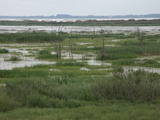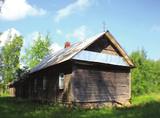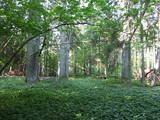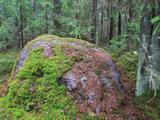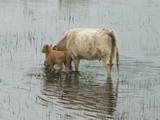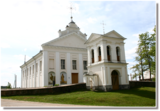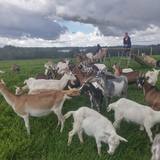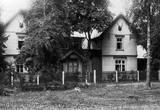| Nr | Nosaukums | Apraksts |
|---|---|---|
|
No Elkas kalna (viens no augstākajiem Vidzemes augstienes rietumdaļas punktiem) paveras plašs un skaists skats ziemeļu virzienā. Te neliels stāvlaukums, retranslācijas tornis un iedomātais Gaujas sākums.
|
||
|
Lubānas ieplakām, kas pieguļ Lubāna rietumu – dienvidrietumu daļai raksturīgi maz izmainīti mežu un purvu kompleksi, kuros ligzdo daudzas retas un aizsargājamas putnu sugas. Šeit sastopami daudzi reti un aizsargājami biotopi. Teritoriju var apskatīt "no malas", pārvietojoties pa Lubāna dambju sistēmu.
|
||
|
Atrodas sporta un atpūtas kompleksā „Trīssaliņas”. No torņa paveras pievilcīga apkaimes ainava, kas īpaši skaista ir pieneņu ziedēšanas laikā. |
||
|
Paramonovas vecticībnieku kopienas lūgšanu nams celts
1882. gadā.
|
||
|
Ja no Pervalkas (Pervalka) pa Kuršu jomas krastu ar kājām (neliela taka) dosimies Klaipēdas (ziemeļu) virzienā, pēc 10 – 15 min gājiena nonāksim līdz Arkļu ragam (Arklių ragas, citās kartēs – Žirgų ragas), kam iepretim ~ 0,2 km attālumā no krasta uz mākslīgi veidotas akmeņainas salas slejas 14 m augstā bāka. Tā celta ~ 1900. g. vietā, kur savienojas trīs kuģu ceļi no Klaipēdas, Nidas un Ventes raga (Ventės ragas). No šejienes paveras fantastisks skats un Nagļu dabas rezervāta iespaidīgajām kāpām. |
||
|
Lietuvas pierobežā atrodas Latvijai samērā unikāla teritorija – gāršas tipa mežs, kurā aug ozoli (daudz dižozolu), liepas, oši (ošu meži Latvijā – retums) u.c. lapukoki. Vietējā gida – mežziņa pavadībā var izstaigāt nelielu gāršas nogabalu, iepazīt raksturīgākos gāršas apdzīvotājus un to nozīmi dabas ritumā. Dabas liegums veidots mežu biotopu, augu un dzīvnieku sugu aizsardzībai, starp kurām sastopamas daudzas dienvidu reģioniem raksturīgās sugas. |
||
|
Komultēnu dižakmens atrodas Sakstagala pagastā, jauktu koku
mežā ap 700 m no Jēkabpils – Rēzeknes ceļa, uz ZA no Komultēniem.
Tā plakanā virsma un sāni saplaisājuši. Akmens sastāv no joslaina magmatizēta
gneisa. Dižakmens apkārtmērs 15 m, garums 5 m, platums 3
m, augstums 1,8 m, tilpums ap 20 m3.
|
||
|
Nacionālā parka dienvidrietumdaļā jūrā iestiepjas Eldas pussala – skaists un ļoti omaļš ar kadiķu mežu (alvāriem) noaudzis zemes pleķītis ar interesantu jūras krastu, kur atsedzas silūra perioda nogulumieži. No pussalas gala, kurā slejas vecs Padomju armijas robežsargu tornis (apmeklējumam bīstams!), paveras visaptverošs skats uz Vilsandi salu (atpazīstama pēc bākas), Lonalaidas salu (Loonalaid) – otru lielāko Vilsandi arhipelāgā, Salavu (Salava) un citām mazākām saliņām. Dabas mīļotāji var uzmeklēt Eldas klinti (Elda pank) – ~ 2 m augstu un 0,4 km garu atsegumu, kura piekājē var atrast interesantas ūdens izskalotas fosilijas. |
||
|
Zemnieku saimniecība "Indrāni" ir bioloģiska lauksaimniecība - ražotne. Vienīgais uzņēmums Latvijā, kas ražo bioloģiski sertificētas želejas konfektes, turklāt ar interesantām garšām, kā, piemēram, rupjmaizes, sarkanā āboliņa, kumelīšu, liepziedu, alus u.c. Tāpat iespējams nobaudīt arī citus saimniecībā saražotus lauku labumus un našķus, piemēram, sīrupus, ievārījumus un tējas. Nakšņošanai tiek piedāvāta brīvdienu māja ar pirti un telšu vietas. Blakus mājai atrodas dīķis ar peldvietu un laipām. Iespēja makšķerēt un vizināties ar laivu. Netālu ir Amatas upe. Saimnieki uzņem tūristu grupas ekskursijām, tāpat apskatāma senlietu kolekcija. |
||
|
Lieguma, kas izveidots Ķīšezera ziemeļu un austrumu piekrastē, galvenās vērtības ir biotopi - ezera palieņu un sausieņu pļavas, kāpas, Ķīšezera akvatorija, piekraste, meži (ozolu, melnalkšņu, skujkoku u.c.) un daudzie dižozoli liegumā un ārpus tā. Liepusalas pussalas dienviddaļā paceļas Bulduru pilskalns - Rīgas izteiktākais senču pilskalns. Pie lieguma robežas atrodas Vārnas – Etnogrāfiskā brīvdabas muzeja filiāle.
|
||
|
Omulīgais krodziņš Elvas centrā nodrošinās jums ne tikai pilnu vēderu, bet arī draudzīgu atmosfēru. Daudzveidīgajā ēdienkartē sev iemīļotus ēdienus atradīs pat visizvēlīgākie apmeklētāji, tai skaitā vegāni. Ir iespējams noīrēt telpas, pasūtīt maltītes. Vasaras sezonā pieejama arī ārējā terase. |
||
|
Produktu izgatavošana no ārstniecības augiem - tējas, sīrupi, augu pulveri, ziedes. Pakalpojumu piedāvājums - ekskursijas, radošās darbnīcas, meistarklases, pirts. |
||
|
Ūdensdzirnavas meklējamas Babrungas (Babrungas) ciema ceļa malā. Dzirnavu ēka ir celta 1816. g. un mūsdienās tajā iekārtota Leonarda Čerņauska (Leonardas Černiauskas) darbnīca un mākslas galerija. Tajā apskatāmas meistara gleznas, koka izstrādājumi un tuvākajā apkārtnē savāktā senlaicīgo priekšmetu kolekcija. |
||
|
Krogs "Aitiņlauvas" atrodas Rīgas - Liepājas autoceļa (A 9) 22. kilometrā. Kroga „rozīnīte” ir ēdieni, kas gatavoti no meža veltēm. Interjers veltīts medniecības tematikai. Blakus izvietots aploks ar dambriežiem. Latviešu virtuve: buka cepetis, mežacūkas cepetis, brieža šķiņķa steiks, jēra cepetis, pildīta strauta forele. |
||
|
“Jēru klubs” ir zemnieku saimniecība, kura pamatā nodarbojas ar aitkopību. Iespējams iegādāties bioloģiski tīru un veselīgu jēra gaļu, dziju, aitādas, vaislas materiālu - teķīšus un aitiņas audzēšanai, kā arī aitkopības inventāru - elektriskos žogus ganīšanai aplokos. Jēru klubs ir zemnieku saimniecība Mazsalacā, kas īpaša ar to, ka aitiņas dzīvo īstā klubā! Saimnieki piedāvā piedzīvot lauku saimniecības atmosfēru, kurā galveno lomu spēlē aitas. Baudīt jēra gaļas un aitu piena produktu ēdienus, sajust, cik ērti ir lasīt savu mīļāko grāmatu, sēžot uz pūkainas aitādas un, lai vakarā pie ugunskura nesaltu, iegūt savā īpašumā siltas vilnas zeķes un austus vilnas apmetņus. Saimnieki aicina ģimenes no Latvijas un visas pasaules viesoties ilgāk, nakšņojot jaunajā Glempinga teltī, maksimāli tuvu dabai un veselīgai lauku videi, nezaudējot ne nieka no komforta, ko esam raduši baudīt ikdienā. Ekskursijas laikā saimnieki Ilze un Valters labprāt dalīsies pieredzē par aitu audzēšanu un kopšanu, bet pēc iepriekšējas vienošanās arī pagatavos gardu maltīti no jēra gaļas.Ja ir vēlēšanās, ekskursija Jēru klubā tiek papildināta ar dažādām aktivitātēm - spēlēm, viktorīnu un radošām darbnīcām, izmantojot aitas vilnu. |
||
|
Seklais un aizaugošais (ap 65 %) Engures ezers ir ne tikai viens no bagātākajiem Latvijas putnu ezeriem (Ramsāres konvencijas vieta, konstatētas 186 ligzdojošo putnu sugas), bet tā apkārtne izceļas arī ar lielu botānisko daudzveidību (> 800 augu sugas). Atšķirīgais jūras krasts (smilšaini liedagi, piejūras pļavas u.c.), piekrastes meži, zvejniekciemi, mitrie meži rada lielu ainavas un sugu daudzveidību. Ezera un jūras palieņu pļavas tiek noganītas ar dzīvei savvaļā pielāgotiem mājlopiem – zirgiem, zilajām govīm u.c. Apmeklētājiem ir izveidoti vairāki putnu vērošanas torņi, Orhideju taka u.c. Engures ezera austrumu krastā atrodas Ornitoloģisko pētījumu centrs un unikālā ornitologu konstruētā peldošā māja. Teritorija ir piemērota ne tikai atpūtniekiem, bet arī kājiniekiem, velotūristiem un putnu vērotājiem. Netālu no Ornitoloģisko pētījumu centra ir izveidota atpūtas vieta un neliela ekspozīcijas māja. |
||
|
Atrodas iepretim Bebrenes muižai, Ilūkstes – Biržu ceļa malā. Baznīcas celtniecība noritējusi ilgākā laikā: 1797. g. to uzsāka, bet pabeidza tikai 1883. g. Ēkas veidolā ir vērojamas klasicisma, bet interjerā – baroka stila formas. Dievkalpojumu laikā baznīca ir apskatāma no iekšpuses. |
||
|
Piemājas saimniecībā, kas atrodas netālu no Jumurdas ezera, ražo kazas sieru, ko iegūst no 40 slaucamām kazām (kopā – 60 kazas). Produkciju var iegādāties uz vietas, kā arī mājražotāju tirdziņos. Produktus piegādā pēc pieprasījuma. Saimniecībā notiek ekskursijas – iepazīšanās ar kaziņu Boniju, viņas draudzenēm un siera degustācija. |
||
|
The former name of the house was “Forstei” (Forester’s House). It was built using logs of the old Bīriņi Castle. The first owner of the building was Alexander Alexei von Pistohlkors, the baron of Bīriņi Manor. It used to be a house of the manor’s chief forester Pauls Moltrehts. The building served as the chief forester’s work place and residence, as well as the Manor’s hunting base. The building was rebuilt several times. It obtained its current appearance and also the symbolic deer antlers in 1891. During the times of the Independent State of Latvia the house obtained a Latvian name – “Meža māja” or “Forest House”. Ownership of the house has repeatedly changed. In the 1930s, the house became a recreation place for cultural professionals and artists. In 1937, the composer Alfrēds Kalniņš spent the summer in the house working on an interpretation of the score for the second staging of the first Latvian opera “Baņuta”. During the post-war period – from 1945 to 1956 – the building housed Saulkrasti Village Council, and during the times of Saulkrasti District it was the location of the People’s Education Department. Later the children’s sanatorium “Ugunskurs” was transferred from Jūrmala to this building and was renamed “Saulkrasti Children’s sanatorium”. Now the building is privately owned. |
||
|
Puises „centrā” uz vienstāvu koka mājiņas jumta izveidota skatu platforma. No tās paveras laba ainava uz ciemu, ostu un piekrastes kadiķu laukiem. |
||

